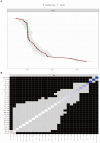Network analysis of interpersonal conflict, emotional exhaustion and psychological distress among mental health nurses in the workplace: a cross-sectional survey
- PMID: 40520318
- PMCID: PMC12162648
- DOI: 10.3389/fpubh.2025.1559351
Network analysis of interpersonal conflict, emotional exhaustion and psychological distress among mental health nurses in the workplace: a cross-sectional survey
Abstract
Background: Mental health nurses (MHNs) frequently engage in intense interpersonal interactions and encounter various forms of conflict with patients, colleagues, and their families. These conflicts can disrupt workplace harmony and significantly affect nurses' mental wellbeing. This study aims to analyze how workplace interpersonal conflicts affect nurses' emotional exhaustion and psychological distress through structural network analysis.
Methods: A cross-sectional descriptive correlational survey was conducted using the Customer Interpersonal Injustice Scale, Interpersonal Conflict at Work Scale, Bi-directional Work-Family Conflict Scale, Maslach Burnout Inventory (emotional exhaustion sub-scale), and the 6-item Kessler Psychological Distress Scale. The survey was completed by 858 MHNs and 643 non-MHNs across six comprehensive hospitals and nine psychiatric hospitals from western China.
Results: 5.1% of all participants reported severe distress. Emotional exhaustion and psychological distress were associated with lower subjective social status, more severe conflicts with patients and supervisors, and bidirectional work-family conflict. Key risk factors for severe psychological distress included being an MHN, patient mistreatment, and bidirectional work-family conflict, while higher subjective social status was a protective factor. Network analysis showed no significant differences in conflict structures between MHNs and non-MHNs. Within the network, the work-to-family conflict most significantly impacted emotional exhaustion, while emotional exhaustion had the greatest influence on psychological distress.
Conclusion: This study revealed that MHNs experienced a higher rate of severe psychological distress than non-MHNs, with emotional exhaustion and psychological distress closely associated with subjective social status and interpersonal conflict. Given that work-to-family conflict and emotional exhaustion were key nodes in the network, targeted interventions are urgently needed to alleviate psychological distress.
Keywords: burnout; emotional exhaustion; interpersonal conflict; mental health nurses; psychological distress.
Copyright © 2025 Qiu, Li, Zhou, Sun, Li and Tang.
Conflict of interest statement
The authors declare that the research was conducted in the absence of any commercial or financial relationships that could be construed as a potential conflict of interest.
Figures






Similar articles
-
Unravelling the link between alexithymia and psychological distress in nurses: a multi-hospital cross-sectional study exploring the mediating roles of workplace conflict and emotional exhaustion.BMC Psychiatry. 2025 Apr 2;25(1):319. doi: 10.1186/s12888-025-06742-2. BMC Psychiatry. 2025. PMID: 40175983 Free PMC article.
-
The relationship between impostor phenomenon and emotional exhaustion among Chinese nurses: the mediating role of bi-directional work-family conflict.Front Public Health. 2025 Jan 15;12:1410452. doi: 10.3389/fpubh.2024.1410452. eCollection 2024. Front Public Health. 2025. PMID: 39882135 Free PMC article.
-
Sex differences in burnout and work-family conflict among Chinese emergency nurses: a cross-sectional study.Front Public Health. 2024 Dec 6;12:1492662. doi: 10.3389/fpubh.2024.1492662. eCollection 2024. Front Public Health. 2024. PMID: 39712298 Free PMC article.
-
Patient mistreatment, emotional exhaustion and work-family conflict among nurses: a moderated mediation model of social sharing of negative work events and perceived organizational support.BMC Med Educ. 2024 Sep 27;24(1):1041. doi: 10.1186/s12909-024-06022-9. BMC Med Educ. 2024. PMID: 39334234 Free PMC article.
-
Work-family conflict and burnout among Chinese female nurses: the mediating effect of psychological capital.BMC Public Health. 2012 Oct 29;12:915. doi: 10.1186/1471-2458-12-915. BMC Public Health. 2012. PMID: 23107113 Free PMC article.
References
-
- Seery BL, Corrigall EA, Harpel T. Job-related emotional labor and its relationship to work-family conflict and facilitation. J Fam Econ Iss. (2008) 29:461–77. 10.1007/s10834-008-9116-9 - DOI
-
- Freedman BD. Risk factors and causes of interpersonal conflict in nursing workplaces: understandings from neuroscience. Collegian. (2019) 26:594–604. 10.1016/j.colegn.2019.02.001 - DOI
MeSH terms
LinkOut - more resources
Full Text Sources
Medical

